Explore the trends in vessel design, materials and certification shaping Australia’s domestic fleet. See what was built, where, and how vessels are evolving to meet industry needs.

About the report
In 2023–24, AMSA certified 1,445 new domestic commercial vessels. These vessels support industries including offshore energy, aquaculture, tourism and transport.
Our New Build Trends report highlights how the fleet is evolving — from larger, more specialised vessels to the rise of autonomous technology, new materials like HDPE and the emergence of alternative fuels. These trends reflect how vessel design, construction and use are shifting to meet industry needs.
Snapshot of 2023-24 new builds
| Fact | Detail |
|---|---|
| Total new domestic commercial vessels certified | 1,445 |
| Non-survey vessels (EX02) | 957 |
| Survey vessels | 363 |
| Restricted C vessels (EX40) | 126 |
| Autonomous vessels | 30 (approximately) |
| Average length (excluding non-survey) | 15.02m |
| Largest vessel | 123.8m (MinRes Coolibah & Airlie) |
| Smallest vessel | 2m (inflatable for seabed survey) |
| Most common materials | Aluminium |
Read the full report
The full report includes:
- Data on new builds by certificate type, use category and location
- The 6 key trends shaping Australia’s domestic fleet
- Construction material trends
- Notable vessel highlights, including tugs, ferries and tourism vessels
Find out more
Last updated: 22 July 2025